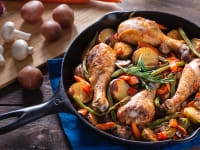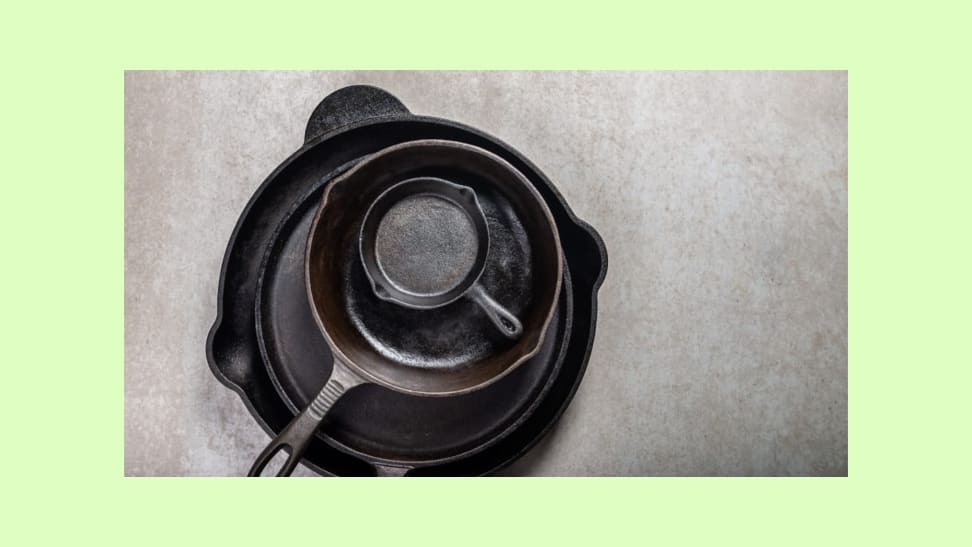 Credit:
Getty Images / Manuta / Reviewed
Credit:
Getty Images / Manuta / Reviewed
Recommendations are independently chosen by Reviewed's editors. Purchases made through the links below may earn us and our publishing partners a commission. Prices were accurate at the time this article was published but may change over time.
Is there a cast-iron skillet in your kitchen? If so, congrats! You’re the proud owner of a durable piece of metal that gets and stays hot, radiates enough heat to cook even a whole chicken all the way through, has a naturally nonstick cooking surface, and enhances the flavor of your food.
Though we love cast iron skillets for their versatility—used from stovetop to campfire to fry chicken, create sides, and serve one-pan dishes like this savory Dutch baby—these pans can be a pain to clean and maintain. Here are the instructions to properly clean a cast-iron skillet after each use.
What You Need:
Tools:
Time Needed:
15 minutes
Difficulty:
Easy
Step-by-Step
How to clean a cast-iron skillet
Step 1
Make sure you’ve built up sufficient seasoning on your skillet (a pre-seasoned cast-iron skillet should come with this).
Step 2
Wash gently with warm water, a small amount of dish soap, and a soft sponge. You can use the scrubby side of the sponge for any tough spots or stuck on bits, just take care not to scrub too vigorously. A scrubbing brush will also do.
Step 3
Pat dry with a dish towel. Set the skillet on your cooktop or range top and turn the burner on high, allowing any remaining water to evaporate.
Step 4
Pour a small amount of vegetable oil in the skillet and rub it all over with a paper towel. Continue heating the skillet on high until the cooking oil starts to smoke. Remove it from the heat and rub it down once more to remove excess oil. Pour any excess oil off with the pour spout.
How can I season my cast-iron skillet?
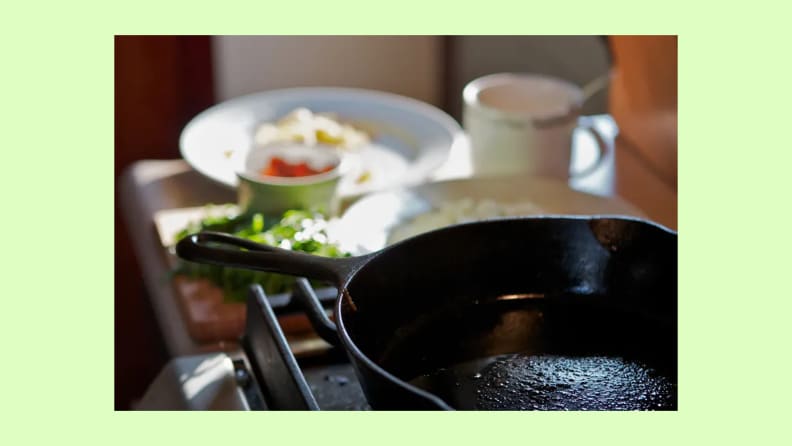
Maintaining a shiny coating of seasoning is vital for the longevity of your cast iron.
You may have heard many cast-iron masters talking about "seasoning" their skillets. Though understanding how to clean a cast-iron pan can protect it from rusting, developing a layer of seasoning can give the pan a nonstick coating.
The magical cooking properties of cast iron come courtesy of a layer of polymerized oil often referred to as "seasoning." You can build up this crucial layer over time by repeatedly oiling and heating the pan.
There are plenty of reliable how-to guides on how to handle the initial seasoning of a new skillet, so we'll skip over that. This advice is all about keeping your pan in good shape once you start cooking with it.
Also note that enameled cast iron pans and Dutch ovens follow different rules. Because of their glass coated surface they are naturally nonstick.
Why is seasoning important?
Because seasoning is vital if you want your pan to remain usable. The shiny coating gives your pan nonstick properties, readying it to handle foods like eggs that might otherwise bond to the metal. It also protects the pan from water, which can cause rust.
It's iron’s propensity to rust that makes cast iron trickier to clean than stainless steel or nonstick. Luckily, with just a little extra care, you’ll be able to keep your skillet clean without destroying the vital seasoning. (And don't worry: If you mess up, you can always start the seasoning process from scratch.)
How to care for your cast-iron cookware
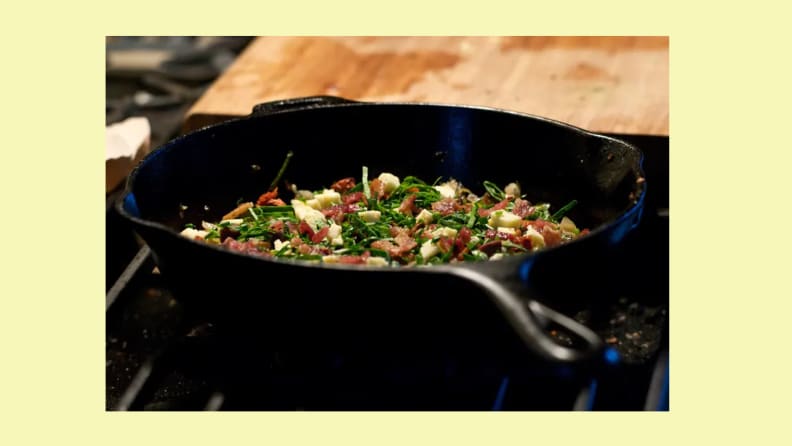
Seasoning protects your pan from bonding with food.
Many cast-iron aficionados will tell you that you shouldn't use soap to wash your skillet, since it will strip away those crucial oils. Not so!
See, there’s a significant chemical difference between oil and polymerized oil. Seasoning is oil that's been broken down into a plasticky material and bonded with the metal of the pan. A small amount of soap, gently applied, shouldn’t harm it. Just make sure you’ve built up a good base layer first.
Many folks skip soap altogether, or use baking soda instead of soap, and you can too if you’re really nervous. (But know that my trusty skillet has never been harmed by a little gentle dish soap.) Likewise, there’s a common misconception that scrubbing your cast-iron pan will scrub away all the seasoning. But as long as you’re not too rough, you should have no such issue.
The scrubby side of a sponge or a stiff brush should be fine, though you should avoid really going to town on the thing and be mindful of material. Keep steel wool far away from your cast-iron pan. Metal scrapers can also cause harm—we recommend favoring a wooden spoon as you cook instead. Seasoning is tough, but not so tough that something as abrasive as steel wool or a metal scraper won't wear it away.
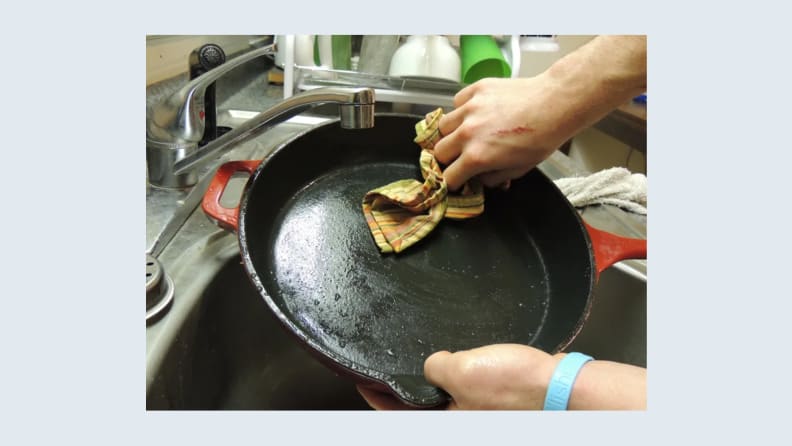
It's okay to wash your cast iron with water, so long as you dry it thoroughly afterwards.
If you’re dealing with tough bits of stuck-on food and want to be extra careful, you can try scrubbing the pan with coarse kosher salt, as suggested by Bon Appetit.
Water is cast iron's mortal enemy. Seasoning can only do so much to protect the metal from rust-inducing moisture, so you’ll want to keep your pan dry as often as possible.
You can wash your cast iron with hot water, but take care not to let it soak for an extended period of time. And when you’re done washing, don’t air-dry. I like to wipe mine down with a towel, then set it on top of the stove and heat it until any remaining moisture has evaporated.
How to re-season your skillet
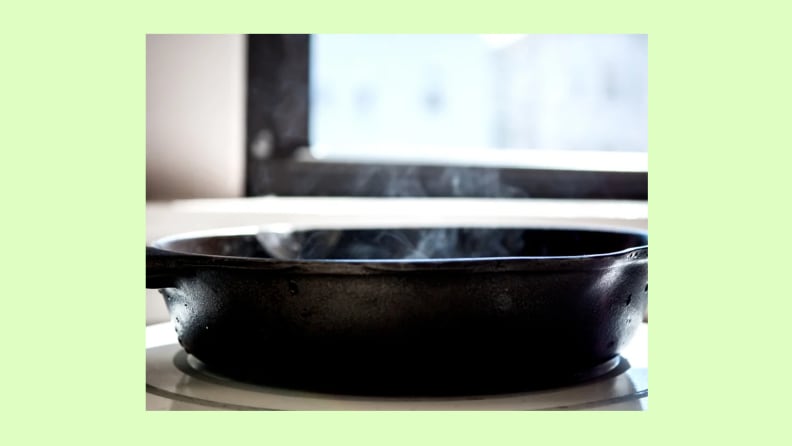
After cleaning and drying your skillet, rub it down with oil and heat it until it smokes.
While your skillet is heating on the stove after washing, you may as well continue to build up your seasoning.
When the residual water has evaporated, pour a small amount of vegetable or canola oil into the skillet and carefully rub it all over with a paper towel. Continue heating the skillet on high until it starts to smoke. Then, take it off the heat and rub it down one more time to remove any excess oil.
This is a quick way to build up and maintain your seasoning. Cast iron might be slightly trickier to clean than other kinds of pans, but once you’re used to it, you’ll find the process fairly painless.
The payoff? A great pan that will last you forever.
You’re on your way to becoming a kitchen master. Take the next step and sign up for Chef's Course. You’ll get weekly tips, tricks, and recipes from top chefs sent straight to your inbox. It’s a whole master course for free.


